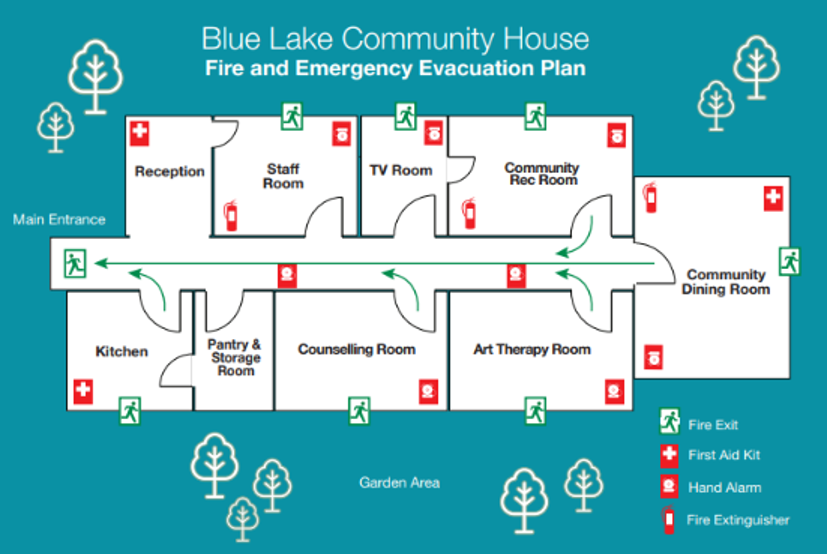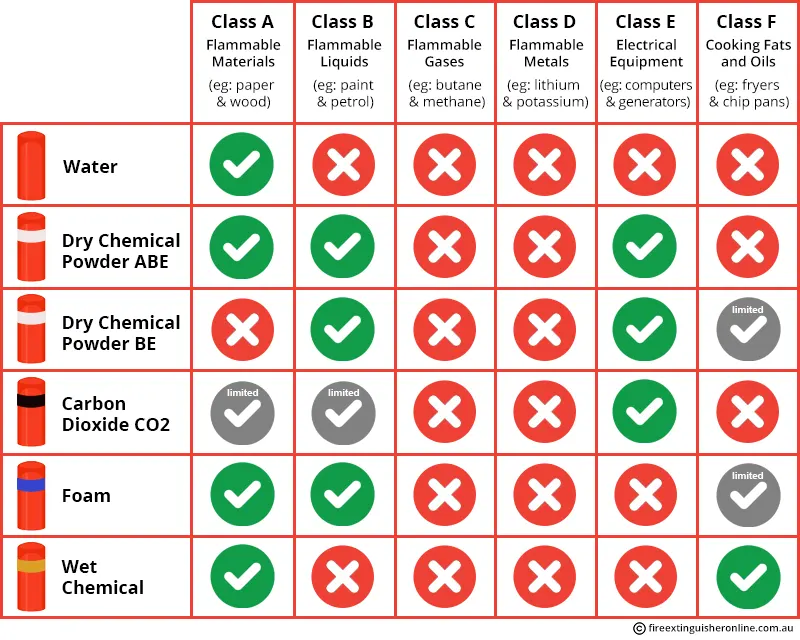Emergency procedures include safety procedures for fire, emergency and first aid. Whilst we hope that we never encounter any of these situations, it is inevitable that at some stage we will, and it is critical we understand our responsibilities to follow all emergency procedures. In this chapter we will investigate first aid in the workplace as well as fire and emergency evacuations.
By the end of this topic, you will understand:
- how to recognise emergency and evacuation procedures
- how to access first aid in line with organisational policies and procedures.
Your employer is required to develop and inform you of a range of emergency procedures such as re and evacuation processes, first aid and emergency response.
What Is An Emergency?
An emergency may be defined as a serious situation that happens unexpectedly and requires immediate attention.
What is a workplace emergency?
A workplace emergency is an unforeseen situation that threatens your employees, customers or the public. It may disrupt or shut down your operations. It may cause physical or environmental damage. Emergencies may be natural or manmade.
Examples of workplace emergencies may include:
- Fire
- Gas leaks
- Explosions
- Bomb threat
- Injury from machinery and equipment
- Electrocution, injuries
- Hazardous substances and chemical spill
- Serious injury events or medical emergencies
- Hostage situations or terrorism.
Fire and Emergency Procedures
Under WHS legislation, your workplace is required to have an evacuation plan that will include similar procedures to the diagram shown.
Fire and evacuation procedures are reliant on a number of points:
- Fire exits and evacuation routes being clear and accessible
- Staff having adequate training and understanding of evacuation procedures
- Equipment and signage being in good working order.
For any emergency or fire in the workplace, as a worker you have a responsibility to comply and cooperate with your organisation’s WHS policies and procedures, alongside any policies and procedures that relate to emergencies and fire.
How do you know it's an emergency?
Each service will use specific emergency signals or alarms to indicate an emergency response is required. Usually, this will be an alarm that is part of the service building, but other times it could be a whistle, air horn, bell or megaphone. Some services have an alarm for a fire alert and a different sounding alarm for an evacuation.
In some services, there may be visual devices (flashing lights) and/or audio devices that notify individuals of a fire event.
You will need to be able to recognise and respond quickly to the alarm once signalled as well as be aware of how to trigger the alarm should you identify the need for evacuation. This information should be given to you at induction.
Following Emergency and Contingency Plans
Part of your overall induction as a new employee has to include a WHS induction. Part of this process will include a walkthrough of your workplace so that you are familiar with:
- Emergency signage
- Exit and entry points
- The location of emergency equipment
- Where to locate first aid or a first aider
- Emergency meeting points
- Bulletin boards where information is updated.
Under WHS legislation, a business must ensure that an emergency plan is prepared that is specific to its workplace and location. If you visit several workplaces, then you need to look at the emergency plan at each location. Emergency plans should be easily accessible to workers. For example, displaying an emergency plan for workers on a bulletin board so that they can familiarise themselves with it prior to an emergency occurring.
Emergency plans aim to:
- Reduce threats to people, property, the environment and the business.
- Control and minimise the impact of any event.
- Ensure that the responsibilities of key people are clear to everyone (who does what) with an appropriate back-up in each case.
- Ensures that people receive appropriate information, training and back-up in order to perform their roles safely.
First Aid and Injury
Your employer is obligated to provide first aid support for all who enter the workplace. The model code of practice (Safe Work Australia, n.d. [G]) defines factors such as:
- Responsibilities for providing first aid
- First-aid requirements based on the nature of the workplace, specific hazards, size and location of the workplace and number of workers
- The requirement to provide first aid facilities and training to workers.
First aid facilities may range from a dedicated medical support staff member and first aid room to having a number of trained first aiders on staff. Regardless of size, your organisation must have first aid kits on site.
Injury and Incident Reporting
If you are injured at work, even if it seems like a minor incident, you should report the injury in line with your organisation’s procedures. This usually includes adding an entry to an injury register or completing an injury report. Depending on the severity of your injury, you should seek medical treatment before completing any reports.
Completing workplace documentation relating to injury ensures that:
- You will be covered by worker’s compensation
- Your employer can identify any hazards that led to the injury
- Your workplace becomes safer for you and your colleagues.
Case Study
Rosemary Sustains an Injury
Rosemary cuts her finger with the cutter while she was unpacking the new folding chairs for the function room. The cut is quite deep and bleeding abundantly. Robert, the staff member who was assembling the new tables, comes to Rosemary’s aid wrapping her finger in lots of tissues from the box on the table close by. He helps her to a chair and calls for one of the Centre’s First Aid qualified staff, Hai, to assist.
Hai examines Rosemary’s finger and determines that she needs to be seen by a doctor. Rosemary returns to work after a few days with her finger heavily bandaged. She is placed on light duties for two weeks while her finger heals.
Activity
Case Study: Rosemary Sustains an Injury
What should Rosemary do to ensure that she is compliant with typical workplace procedures surrounding accident and injury?
Workplace Emergency Procedures
At all times employers and workers need to work together to:
- Recognise potential hazards.
- Assess the likely risk and damage.
- Plan timely controlled emergency responses.
- Ensure all persons stay informed and safe.
Fire
- All staff should know to access the nearest telephone to contact emergency services by calling 000.
- Staff should be trained in the operation of firefighting equipment and fire alarms.
- All exits should be well signed and clear from obstructions. Fire doors should remain closed.
- Evacuation routes and plans should be clearly documented and practised.
- Shutting down procedures should be documented.
- Use fire exits, or stairwells. Do not use lifts in a fire.
Hazardous substances
- All staff should know to access the nearest telephone to contact emergency services by calling 000.
- Material safety data sheets (MSDS/SDS) should be referred to for emergency information.
- All staff should remain in a well-ventilated area, downwind from any fumes or vapours.
- Evacuation routes and plans should be clearly documented and practised.
Medical emergencies
- The extent of the injury or illness should be assessed.
- Emergency services should be contacted by calling 000, and an ambulance should be requested.
- The first aid officer and first aid supplies should be accessed if appropriate.
Aggressive or violent behaviour
Staff may have to deal with aggressive or intoxicated clients or the threat of violence from a theft or robbery. The following steps should be followed:
- Minimise interaction and do not antagonise the aggressor.
- Seek assistance from experienced staff or emergency services.
- Report all incidents.
Staff should take care when handling any money or other items of value. The risk of theft can be reduced, and personal safety can be improved through the use of security systems, surveillance cameras and safes where money and valuables can be locked away.
De-esculating Techniques
De-escalating techniques are essential for professionals in community services, especially when dealing with aggressive or potentially volatile clients. These techniques help maintain a safe and productive environment for both the client and the service provider. Here are some strategies to deescalate a situation with an aggressive client in community services:
- Stay Calm
Your own demeanour and emotions can have a significant impact on the situation. Maintain a calm and composed presence. Speak in a calm and even tone, and avoid becoming confrontational or agitated. - Active Listening
Listen carefully to the client without interrupting or judging. Let them express their feelings, concerns, and frustrations. Demonstrating that you understand their perspective can help defuse tension. - Non-verbal Communication
Use open body language to convey that you are approachable and non-threatening. Maintain appropriate eye contact, and avoid crossing your arms or displaying any aggressive body language. - Maintain Personal Space
Respect the client's personal space and boundaries. Standing too close can make them feel threatened, so maintain a safe distance. - Empathy and Validation
Show empathy by acknowledging the client's feelings and concerns. Use phrases like, "I understand that you're frustrated," or "I can see that this situation is upsetting for you." Validating their emotions can help them feel heard and respected. - Avoid Aggressive Language
Choose your words carefully, avoiding aggressive or confrontational language. Use "I" statements to express your perspective and maintain a non-judgmental tone. - Offer Choices
Give the client some control over the situation by offering choices whenever possible. For example, you could say, "Would you like to discuss this now, or would you prefer to take a break and talk later?" - Problem-Solving
Collaboratively work on finding solutions to the issues causing the aggression. Engage the client in brainstorming options and encourage them to consider the consequences of their actions. - Set Boundaries
Clearly communicate the boundaries and expectations for behaviour in a respectful manner. Be firm but not aggressive when stating what is acceptable and what is not. - Safety First
If the situation escalates to a point where someone's safety is at risk, ensure the safety of all involved. This might involve calling for backup or involving law enforcement if necessary. - De-escalation Team
In some cases, having a trained de-escalation team or colleagues available to assist can be invaluable in diffusing a situation safely. - Follow-Up
After the immediate crisis has passed, follow up with the client to discuss the incident and explore long-term solutions. This can help prevent future confrontations.
It's important to remember that de-escalation techniques may vary based on the specific situation and the client's needs. Training in conflict resolution and de-escalation is often crucial for professionals working in community services to ensure they can handle aggressive behaviour effectively and safely.
Bomb threat
Important things to remember in the event of a bomb threat are:
- Don’t antagonise or provoke the person making the threat in any way
- Consult experienced staff and emergency services
- Try to gather as many details as possible
- Follow evacuation procedures

There can be serious implications for not appropriately following emergency procedures. It is essential that all staff follow the procedures that their workplace has implemented.
In the event of a fire, spillage of hazardous substances or bomb threat, evacuation is the normal procedure.
Our emergency procedures in response to a fire situation will be based on standard fire orders developed by Fire Brigades. These standard fire orders tell us to follow the RACE procedure:
- Rescue — or assist any person in immediate danger
- Alarm — Raise the alarm and follow your emergency procedure
- Contain — Close doors and windows to contain the fire – only if it is safe to do so!
- Evacuate — to the assembly area. Remain at assembly area and ensure all children and staff are accounted for
In an evacuation, the Evacuation Warden is in charge. Do everything they tell you to do!
Look at the following office floor plan and note that it shows an employee the quickest and safest way to exit the building. 4.1.

Every service must display the written emergency plan in each playroom and at each exit from the building.
Fire emergencies
Fire has the ability to ignite and spread rapidly. This makes it one of the most feared and dangerous emergency situations. It is not only the fire itself, which is dangerous but also the smoke it generates. Smoke inhalation is more common than direct exposure to the fire. Smoke inhalation can not only cause illness but can in the most extreme cases, be deadly.
Even with the best intentions of prevention, fires can still occur in the workplace.
In order for a fire to occur, it requires the following:
- An ignition source such as sparks or flame
- A source of fuel. (This may be solid liquid or gas)
- Oxygen
What to do in case of a fire?
If you encounter a fire, remember the following steps:
- Sound the alarm immediately
- Advise everyone to stay clear
- Notify the fire brigade
- Fight the fire only if you have been trained to do so
- Evacuate the premises
- Do not re-enter the building until the fire brigade has given permission to do so
- For electrical fires, remember to turn off the power.
Fire extinguishers
Fire extinguishers are colour-coded so that they are easily identifiable. The type of extinguisher to be used is dependent on the source of the fire and the materials that fuel the fire. If you are in a situation where you have to fight a fire, it is imperative that you identify the most appropriate extinguisher for the job. For example, you would not use a water-based fire extinguisher to fight an electrical fire. Not only will it not do the job, but there is a distinct possibility that the operator may be electrocuted.
Remember that a fire extinguisher is only the first step in firefighting. All small fires can quickly become big fires—and an extinguisher is no substitute for the fire brigade.
The table which follows lists the main types of extinguishers, their colour codes and their special uses.
| Class A Flammable Materials (e.g: paper & wood) |
Class B Flammable Liquids (e.g: paint & petrol) |
Class C Flammable Gases (e.g: butane & methane) |
Class D Flammable Materials (e.g: lithium & potassium) |
Class E Electrical Equipments (e.g: computers & generators) |
Class F Cooking Fats & Oils (e.g: fryers & chip pans) |
|
|---|---|---|---|---|---|---|
| Water | ✓ | x | x | x | x | x |
| Dry Chemical Powder ABE | ✓ | ✓ | x | x | ✓ | x |
| Dry Chemical Powder BE | x | ✓ | x | x | ✓ | ✓ |
| Carbon Dioxide CO2 | ✓ | ✓ | x | x | ✓ | x |
| Foam | ✓ | ✓ | x | x | x | ✓ |
| Wet Chemical | ✓ | x | x | x | x | ✓ |

Halon/BCF fire extinguishers were recalled for disposal in 1995. Anyone with one of these should replace it with a CO2 or dry chemical extinguisher.
Any time a fire extinguisher is used it should be refilled. A used extinguisher may prove ineffective in the future and possibly result in injury or even death for the person trying to use it.
If you notice any extinguishers that have lost pressure or are out of date, arrange to have them refilled as soon as possible.
How to operate a fire extinguisher
There are four (4) basic steps for using modern portable fire extinguishers.
The PASS method is the accepted method:
- Pull Pin
Pull the pin at the top of the extinguisher, breaking the seal. When in place, the pin keeps the handle from being pressed and accidentally operating the extinguisher. Immediately test the extinguisher. (Aiming away from the operator) This is to ensure the extinguisher works and also shows the operator how far the stream travels - Aim
Approach the fire standing at a safe distance. Aim the nozzle or outlet towards the base of the fire. - Squeeze
Squeeze the handles together to discharge the extinguishing agent inside. To stop discharge, release the handles. - Sweep
Sweep the nozzle from side to side as you approach the fire, directing the extinguishing agent at the base of the flames. After an A Class fire is extinguished, probe for smouldering hot spots that could reignite the fuel.
Note: Always test the extinguisher before proceeding to the fire. Remember that you only have seconds to extinguish the fire, not minutes, but only do so if it is safe and you are trained to. The rule of thumb is if you are not able to put a fire out with one extinguisher, then the fire is too big to fight.
Lock Down or Evacuation Procedures
Some emergency situations may require a ‘lockdown’ procedure to be implemented. Lockdown, also known as ‘invacuation’ may occur in situations where it is determined that people are safer, remaining within the confines of the building.
Examples of situations that might require invacuation might be:
- Bushfire
- Chemical spills
- Smoke outside
- Dangerous or threatening people in the nearby area
In these situations, everyone should remain away from windows and openings where they are out of sight.
- The lockdown plan should incorporate the principles of shelter-in-place and be capable of being sustained for an extended period.
- Maintain an up-to-date register of clients/caregiver contact details.
- Have in place a plan for providing advice to clients/caregivers should an extended lockdown be required (be aware that mobile telephone network overload is a possibility).
- Provide advice to clients/caregivers regarding the plans in place and likely actions during an emergency.
Whatever the emergency situation it is important that services understand the impact of emergencies on an individual’s emotional and psychological wellbeing.
Clients need to feel safe and secure during and after instances when they have been exposed to an emergency situation. Staff should provide opportunities for them to discuss their feelings and thoughts about what has occurred. Support from professional counselling services may be required after a traumatic event.
In conclusion, this chapter delves into emergency procedures, covering safety protocols for fire, emergencies, and first aid in the workplace. While we hope to never face these situations, it is inevitable that we will encounter them at some point. Therefore, it is imperative that we comprehend our responsibilities in adhering to all emergency procedures.
